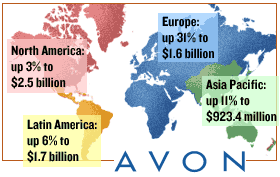NEW YORK (CNN/Money) -
The highly-mobile Avon lady is always looking for an opportunity to sell, and she doesn't believe in taking "no" for an answer even if it's from the leadership of the world's largest nation -- China.
Avon, the New York-based cosmetics behemoth, which boasts a worldwide sales force of 4.4 million representatives, entered China in 1990 and was the first international direct selling company to open doors there.
However, in 1998 the Chinese government instituted a ban on all direct selling in China which outlawed direct-sales operations of companies including Avon, Mary Kay Cosmetics, and Sara Lee.
"The entire direct selling industry was prohibited in China," said Victor Beaudet, spokesman for Avon Products (AVP: Research, Estimates). "In June 1998, Avon was relicensed to start selling our products in the local market," he said, but with a little tweaking to its well-known business model."
China still doesn't allow door-to-door selling, so Avon opened small stores called "beauty boutiques" and put its brand on shelves at beauty counters at local department stores.
According to Beaudet, the products now sell in over 5,500 such boutiques and 1,600 beauty counters.
Last year, the company logged total sales of $157 million in China and expects to cross $200 million in 2004, with plans to open 500 boutiques a year for the next few years.
"China is our number one market opportunity and probably will be for the next 10 years," Beaudet said, and he forecasts the market will grow to about $400 million by 2007.
More importantly, Avon anticipates that with China's entry into the World Trade Organization (WTO), the barrier to direct selling could soon be eliminated, possibly by the end of this year.
Seeking fresher pastures
Although Avon has pegged China as a lucrative market opportunity, the country still represents a very small portion -- less than 5 percent -- of the company's total sales.
At the same time, industry watchers speculate that with its domestic market growth drying up, Avon needs to penetrate the Chinese markets as well as expand into other fresh pastures if it wants to keep growing at its current strong pace.
"Avon's international business is the key to its growth going forward. There's no disputing that," said William Steele, analyst with Banc of America Securities.
Already, about 63 percent of its $6.8 billion revenue in 2003 came from markets outside the United States and Avon operates in over 100 countries.
Carl Sibilski, retail analyst with Morningstar, identifies Russia and South America as two other critical markets for Avon.

"Russia is growing so fast that it's quite hard to estimate its total potential. South America is a region where the its model continues to work very well," said Sibilski.
Last September, the company invested $40 million in a manufacturing facility near Moscow which is expected to be completed this summer. Avon said products manufactured at the new plant will be sold in Russia through the its 194,000 sales representatives in the country as well as in the Ukraine and Kazakhstan.
Russia -- Avon's fastest growing market -- brought in sales of $241 million in 2003, up a whopping 70 percent over the previous year, while total sales in South America rose 6 percent to $1.7 billion. Sales in the South Pacific market, which includes China, rose 11 percent to $923 million.
Sales in the United States weren't as thrilling -- up 3 percent in 2003 to $2.5 billion.
No longer your grandma's brand
One thing that Wall Street is at ease with lately is Avon's pretty profit profile.
Avon recently upped its full-year earnings forecast and now is on track to post its fifth consecutive year of two-digit earnings growth since CEO Andrea Jung took over the reins in 1999.
"This is a company that has gotten stronger under Jung," said William Steele, analyst with Banc of America Securities.
'Before Jung was promoted to the role, Avon had the image of being your grandmother's brand," said Steele. "She's made Avon current and relevant again by reaching out to younger consumers with new brands, new advertising, developing their Internet operations and really improving the company's overall portfolio including jewelry and skin care and not just cosmetics."
So far, investors have signaled their confidence, with the stock up 34 percent year-to-date after climbing 25 percent in 2003.
"This is a company that has everything going right for it, at least for now," said Morningstar's Sibilski. "History has shown that investors are always optimistic about the company. At the same time, the stock does sell off quickly when sales begin to look shaky."
Steele, who has a "neural" rating on the stock is concerned about its lofty valuation. Avon currently trades at a price-to-earnings multiple of 23 times next year's earnings, well above its sector's P/E of 17.4.
Said Morningstar's Sibilski,"Much of Avon's premium valuation is built on the market's expectation that the firm will continue to tick off positive financial results with the precision of a fine watch. While we think Avon has a stable business model, it's not immune to business hiccups."

-- analysts quoted in this story do not personally own shares of Avon and their firms do not have an investment banking relationship with the company.
|

